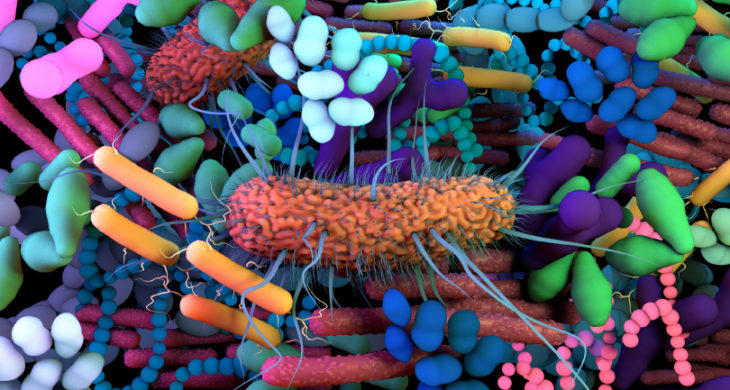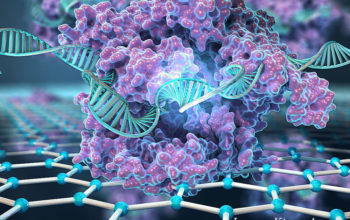
Date: 10th December 2021
Genetic engineering is more precise and available than ever before, and behind the gene editing revolution firmly lies the CRISPR-Cas system. However, to date CRISPR enzymes have only been used to edit the genomes of one cell type at a time. With the microbiome playing crucial roles in health and the immune system for example, and also being linked to a variety of conditions from obesity to anxiety, this is becoming an increasingly important field in the medical arena. Genetic manipulation within isolated microorganisms has been essential to understanding gene function but as most microbes relevant to the environment, industry and health live in communities, knowledge in isolated species is limiting. Now, researchers have developed a two-pronged approach to modifying genes within a community of many different species simultaneously, opening the door for community editing.
Microbial diversity is vast however, our knowledge of their roles within communities and their immensely complex interactions remains somewhat limited. Whilst, we understand that microbes are crucial for example in the carbon, hydrogen and nitrogen cycle, and can virtually affect all aspects of human health, data suggests there is an unexpectedly high degree of interdependence amongst these organisms. The phenomenon known as metabolic handoff, essentially means that no individual microbe is performing a huge string of metabolic functions, but for the most part, each individual organism is doing a single step of a process, and therefore there must be some hand-off of metabolites between microbiota. Currently, these observations are only hypotheses as to date there are no methods to test gene functions and interactions at a community level. However, the ability to edit and track these microbes within a natural community would advance our understanding immeasurably.
Now, researchers at the University of California, Berkeley, US, led by the CRISPR Nobel prize winner Jennifer Doudna, have developed a two-method approach to ‘shotgun’ edit many types of cells or microbes at once and to track them within a community. The team first developed an strategy to determine which microbes in a community were actually susceptible to gene editing, a screening technique called ET-seq (environmental transformation sequencing). Then they developed a targeted delivery system called DNA-editing All-in-one RNA-guided CRISPR Cas Transposase (DART) that used a CRISPR-Cas enzyme to target specific DNA sequences and insert a bar-coded transposon.
Editing organisms in a complex microbiome requires knowledge of which members are accessible to nucleic acid delivery and editing. To address this the team developed ET-seq to assess the ability of individual species within a nine-member microbial consortium to acquire and integrate exogenous DNA. The microbial community was exposed to a transposon (a randomly integrating mobile genetic element) then the total community DNA was extracted and sequenced both before and after exposure. The results showed successfully transposon insertion into five species of microbes using different transformation methods suggesting the ET-seq method could identify and quantify genetic manipulation of microbial community members.
The ability to introduce specific genome edits to a single type of organism within a microbial community, and furthermore target those edits to a defined location within its genome, would be of great benefit. The team therefore turned to familiar territory -using CRISPR-Cas systems. They reasoned that RNA-guided CRISPR–Cas Tn7 transposases could provide the ability to both ablate the function of targeted genes and deliver customised genetic cargo in organisms shown to be genetically tractable by ET-seq. They created DART, a conjugative all-in-one vector system encoding naturally occurring CRISPR-Cas transposon systems, that could insert a bar-coded transposon into the genome allowing for the detection and tracking of uniquely edited microbes. Initial experiments performed in E.coli showed that DART could target genome editing with CRISPR-associated transposases with high target specificity and insertion efficiency.
However, would this translate to targeted species- and locus-specific editing in a more realistic community setting? In order to tackle this the researchers took a stool sample from an infant and cultured it to create a stable community composed mostly of 14 different types of microorganisms. They were able to edit individual E. coli strains within that community, targeting genes that have been associated with disease. In addition, in other examples they were able to simultaneously generate loss-of-function and gain-of-function mutations, and confer new metabolic capabilities to a targeted organism within the microbiota.
Conclusions and future applications
The Doudna lab and colleagues have shown here that together ET-seq and DART can be applied for species- and locus-specific genome editing within microbial communities. ET-seq revealed the genetic accessibility of an individual organism whilst DART enabled precise RNA-programmable genome editing. DART accurately integrated genetic payloads into the individual species of the synthetic soil community and infant gut communities.
The researchers hope to employ the technique to understand artificial, simple communities, such as a plant and its associated microbiome, in a closed box. They can then manipulate community genes within this closed system and track the effect on their bar-coded microbes. The technology could be used to alter the microbial environment of crops for example to make them more resistant to pests.
Longer term they hope to eliminate genes that cause sickness in gut bacteria, or to insert genes into the microbes to fix digestive problems. The technique will likely help us understand better the role of microbes in a wide range of diseases and conditions such as depression, acne, cancer, atherosclerosis or autoimmune diseases.
With microbiomes playing such extensive and critical roles in health and beyond there is great interest in harnessing their power with synthetic biology. There is becoming a strong association between microbiomes and personalised medicine and methods such as ET-seq and DART could help accelerate the field. Researchers are employing novel computational approaches to search the genome of human microbiota for genes that encode drug-like molecules with antibacterial or anticancer properties to overcome resistance, and others are using microbes to build synthetic muscle fibres that are stronger than Kevlar. The ability to unravel gene function, understand microbial communities and the capability to genetically manipulate individual species will make this a highly valuable new tool for scientists and has the potential to address many of our unmet clinical needs, and help shape the future of microbe biology.
For more information please see the press release at Berkeley News
Rubin, B.E., Diamond, S., Cress, B.F., Crits-Christoph, A., Lou, Y.C., Borges, A.L., Shivram, H., He, C., Xu, M., Zhou, Z., et al. (2021). Species- and site-specific genome editing in complex bacterial communities. Nature Microbiology.
https://doi.org/10.1038/s41564-021-01014-7


